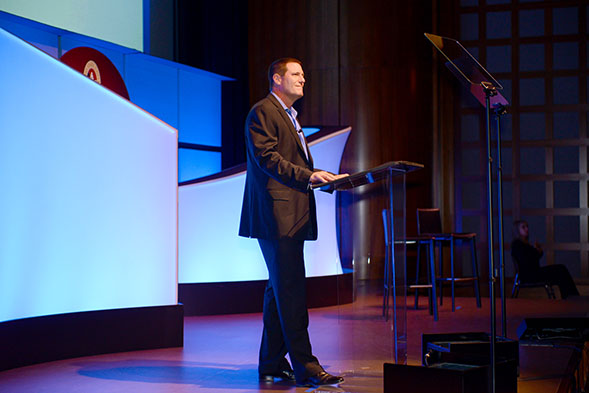Imagineer That
Kevin Mayer, '88, shared his journey from engineer to Imagineer with the SDSU community.

“If you embrace learning as a lifelong pursuit, you will see greater possibilities, find more interesting opportunities and create more value in your life and in the world around you.”
Engineer, corporate strategist for the Walt Disney Company and Aztec For Life.
Kevin Mayer does it all.
Since earning a master's degree in electrical engineering at San Diego State University in 1988, Mayer has made the journey from engineer to Imagineer. He recently got in touch with his Aztec roots when he visited the Mesa to share his experiences during the 2015 President's Lecture Series.
Lifelong learning
"Whatever you learn while you are here is just the beginning — it's a great foundation to get you started, but the world is moving fast and the only way to keep up is to keep learning," said Mayer, who has overseen Disney's strategic acquisitions of Pixar, Marvel, Lucasfilm, Club Penguin and Maker Studios.
"No matter what program you're in, the diploma they hand you isn't the end. It's just the beginning."
Mayer began his educational and professional careers as an engineer, but opportunity led him into the business side of things. He assured students not to fear change, but to embrace it as part of the learning experience.
"No matter what you think you want to do right now, odds are, it's going to evolve throughout your career, because you're going to see opportunities that either don't exist right now, or that you aren't aware of yet," he said.
Through dedication and perseverance, Mayer was able to obtain a job with the Walt Disney Company in 1993. With experience in both engineering and business, Mayer was a strong candidate for a position in strategic planning with a company embracing the emergence of digital media.
Keeping up
Mayer encouraged the audience to be adaptable when it comes to an ever-changing business and media landscape. He praised the Walt Disney Company's ability to grow and change with the demands of markets and consumers, and how doing so has proven to be profitable.
"This is an era of great change — with tremendous disruption and disintermediation as the industry is re-examining traditional models and questioning conventional wisdom," he said. "Every new technology creates more challenges and possibilities. This constant change is the new normal."
Mayer challenged the audience to embrace change rather than fight it, referencing Disney's recent acquisition of the world's largest network of short-form online video — Maker Studios —in response to the changing demands of target consumers.
"We noticed that our younger audience was spending more time watching Youtube. Rather than wringing our hands about what that might mean over the long term of our existing platforms, we decided to follow the viewers," he said.
An Aztec for life
Although Mayer's presentation marked his first return to SDSU in more than two decades, he is still a proud Aztec.
He credits his time at SDSU for helping him gain valuable insight and instrumental experience that helped him break into the industry.
"SDSU is a great school and anyone who holds a degree from this institution should be proud of that," he said.
About Mayer
In addition to his SDSU degree, Mayer holds an MBA from Harvard University and a bachelor's degree in mechanical engineering from Massachusetts Institute of Technology.
Mayer came to SDSU in 1985 with the hopes of developing his knowledge in electrical engineering. He was drawn to the university for its high-caliber faculty, flexible schedule and promising post-graduation options.
Mayer was appointed executive vice president of corporate strategy and business development for the Walt Disney Company in June 2005. In addition to executing all merger and acquisition transactions and strategic investments globally, his duties include leading the group as it finds profitable growth by targeting emerging businesses new to Disney's portfolio, managing cross-divisional issues and opportunities and evaluating new technology and business models.



